Living in the Landscape
Stable House
Overview
Stable House is the first of a two-stage project for a family compound in the inner-city neighbourhood of Forest Lodge. The existing site's complexity adds to its richness: an 1880s late Victorian weatherboard workers’ cottage, a brick horse-stable to its rear, eight terrace houses overlooking the site from the east, and the Orphan School Creek’s bushland regeneration park to the western boundary. The masterplan for both stages propose two buildings inserted to minimise impact onto the bush reserve and views from the terraces. Their roofs slope down to a central garden which will be shared between the two houses and connect with the adjacent native bush reserve. Both homes will have a common outdoor space and shared amenity with the bush reserve.
Stable House, built in the first stage, has been designed by the architect for herself and her growing family. The house sits nestled at the rear of the site behind the cottage within the old heritage brick walls of the stable. (The stables were in a dilapidated state and had not been in use since the 1990s to keep horses for the Harold Park Paceway, which closed in 2010.) The existing brickwork of the stable wraps around the perimeter of the building revealing itself throughout the house in different ways; framed through a large pane of glass, standing separate to the new building, as a full height internal wall and sometimes just a sliver of the wall is revealed.
Central to the home is the kitchen/living/dining room area. A raised white ceiling volume makes this space feel incredibly light and generous. Spotted gum-ply on the kitchen joinery, living room wall linings, ground floor ceiling linings and flooring on the upper floor demarcate the lower half of the house and accentuate the voluminous white ceiling. This light space also contrasts with the warmth and texture of the timber ceilings and exposed brick walls of the ground-floor bedrooms behind. These sleeping and living spaces are also partly separated by a double-height blue-tiled courtyard, which creates an intimate space. A concrete cloud edge embellishes this moment of cool surprise.
On the external facade, papaya-coloured tiles provide a continuation of the warm tones of the heritage brickwork of the stable. The trellis screen that wraps around the north and western facades acts as a shading device as well as a continuation of the adjacent landscape, with the house eventually camouflaged within the bush. Native creepers, Wonga Wonga Vine and Happy Wanderer climb up the trellis of the façade blooming white, pink and purple flowers. This is part of the generous spirit of Stable House whereby a series of architectural devices - compact spatial planning, a sensitive form with a sloping roof, planted trellises, and the retained existing heritage brickwork - strengthens the character of the neighbourhood through acts of camouflage.
Winner of the 2022 Wilkinson Award for New Residential Architecture by the NSW Australian Institute of Architects.
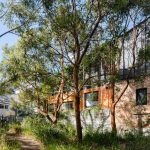
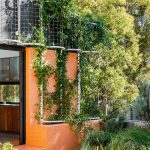
The trellis screen that wraps around the north and western facades acts as a shading device as well as a continuation of the adjacent landscape, with the house eventually camouflaged within the bush.
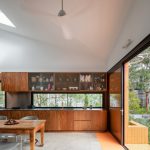
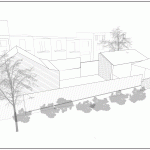
The existing site's complexity adds to its richness: an 1880s late Victorian weatherboard workers’ cottage, a brick horse-stable to its rear, eight terrace houses overlooking the site from the east, and the Orphan School Creek’s bushland regeneration park to the western boundary.
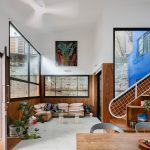
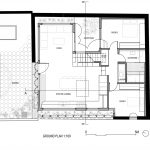
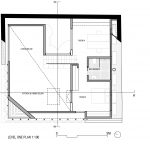
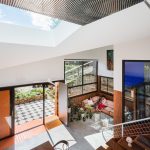
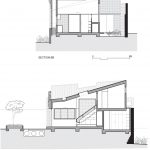
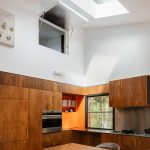
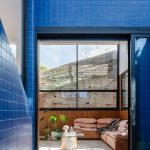
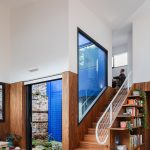
The existing brickwork of the stable wraps around the perimeter of the building, revealing itself throughout the house in different ways.
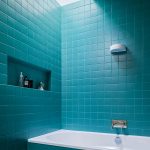
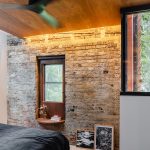
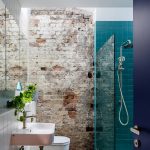
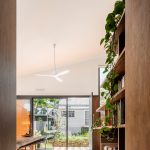
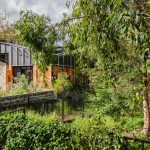
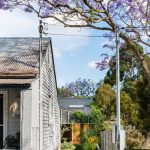


The trellis screen that wraps around the north and western facades acts as a shading device as well as a continuation of the adjacent landscape, with the house eventually camouflaged within the bush.


The existing site's complexity adds to its richness: an 1880s late Victorian weatherboard workers’ cottage, a brick horse-stable to its rear, eight terrace houses overlooking the site from the east, and the Orphan School Creek’s bushland regeneration park to the western boundary.








The existing brickwork of the stable wraps around the perimeter of the building, revealing itself throughout the house in different ways.









